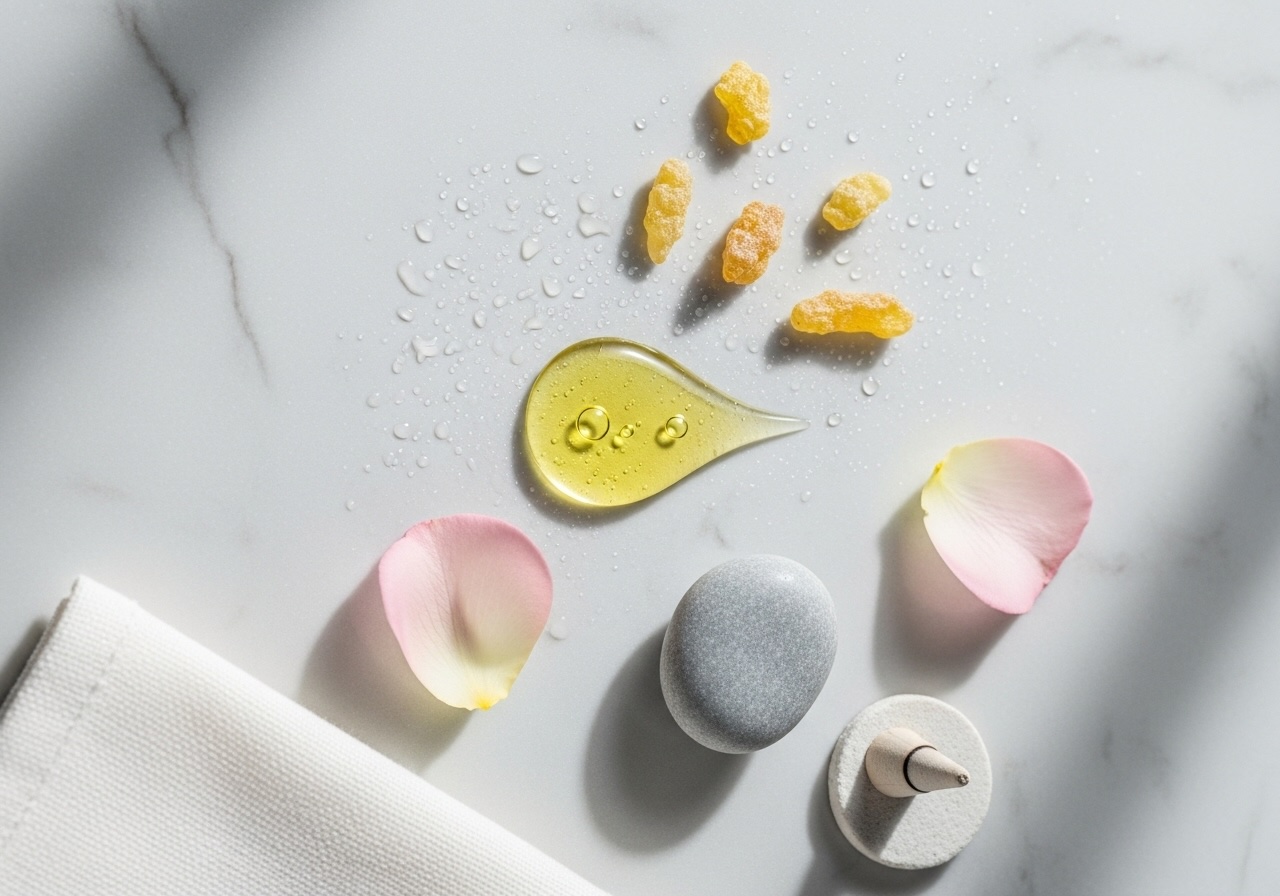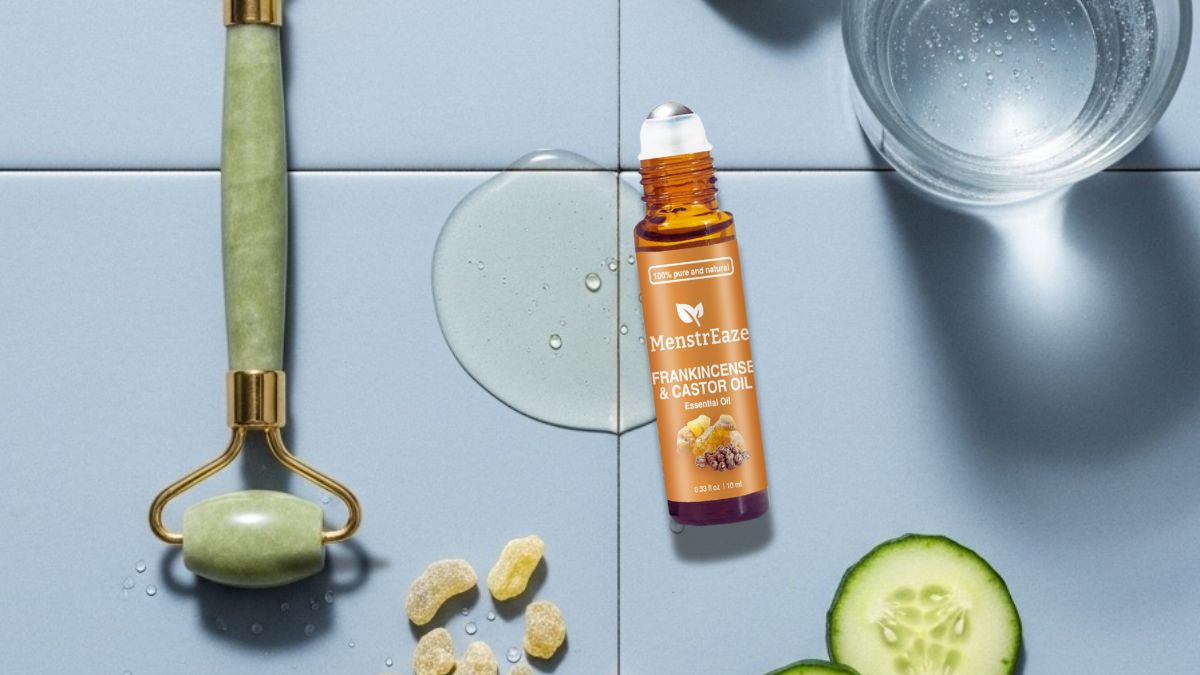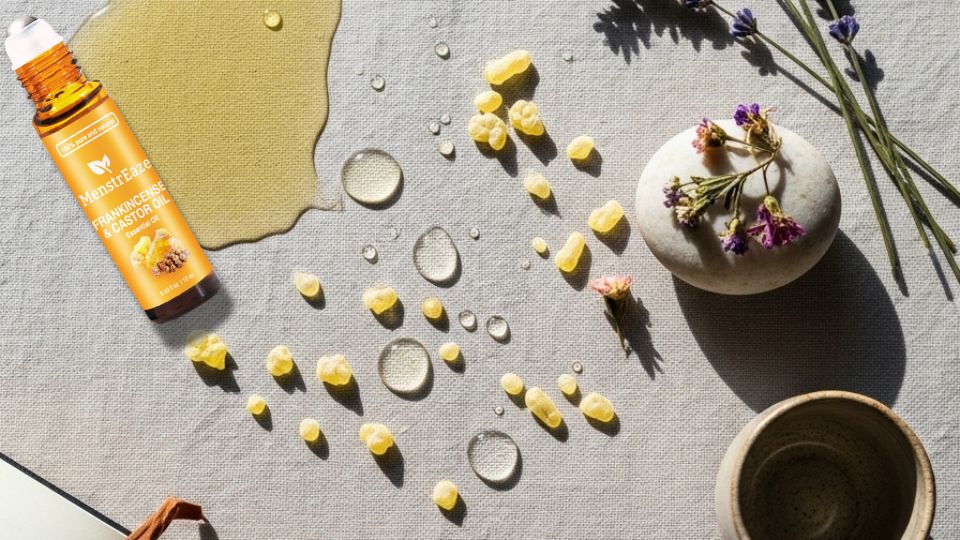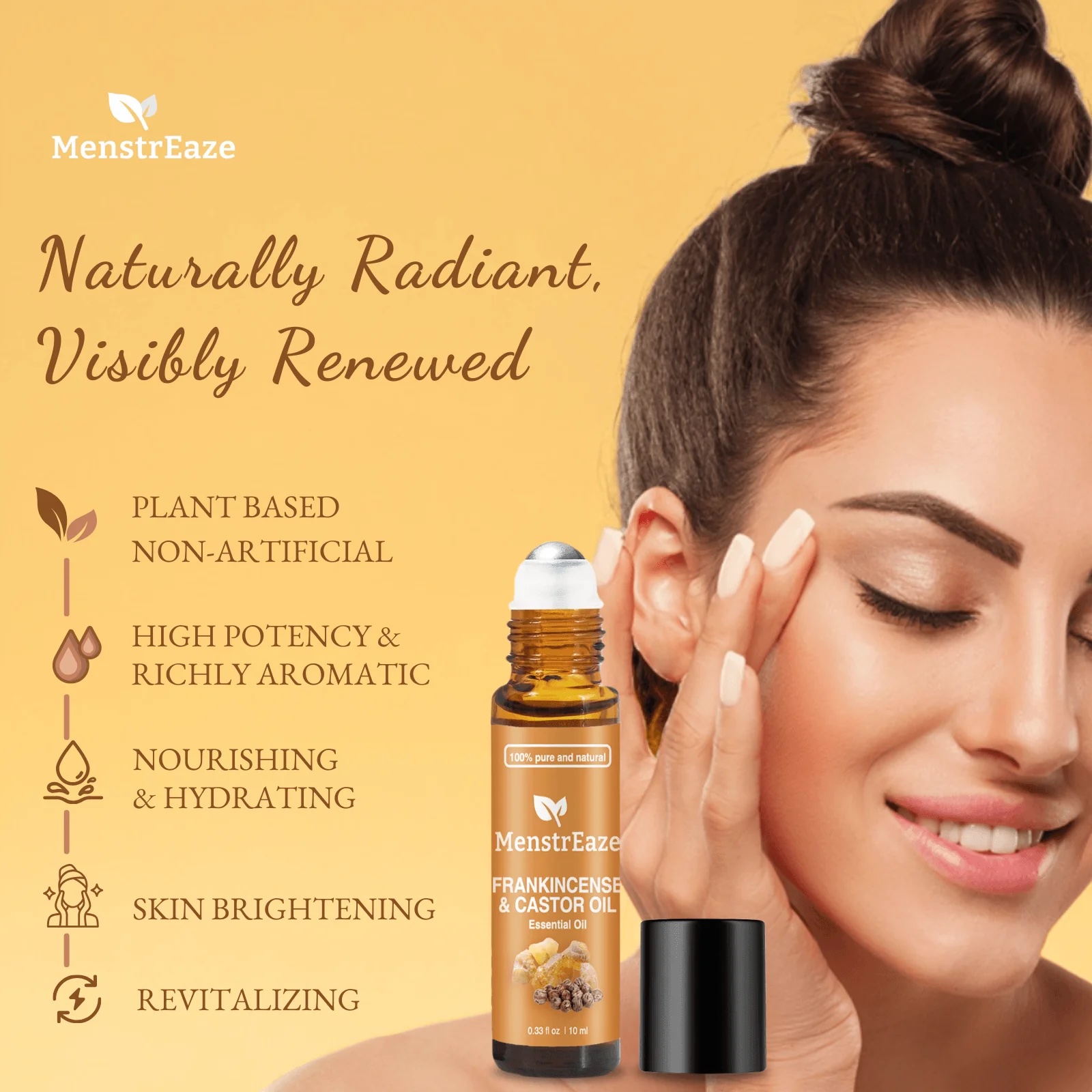
Key Takeaways
(5 min read)
Q1: What are the main frankincense skin benefits?
A: Frankincense essential oil is a potent anti-inflammatory that calms irritation, an antioxidant that protects against environmental damage, and may support skin regeneration to combat signs of aging. Many people look up "skin frankincense oil before and after" results due to these powerful properties.
Q2: What makes castor oil an effective skin treatment?
A: Castor oil is an intense moisturizer that forms a protective barrier to prevent water loss. Its main component, ricinoleic acid, also provides significant anti-inflammatory and antimicrobial properties.
Q3: Why do frankincense and castor oil work well together?
A: The combination of castor oil and frankincense is effective because castor oil hydrates and locks in moisture, while frankincense essential oil calms and protects the skin. MenstrEaze's roller combines both with a cooling massage roller for on-the-go relief and improved circulation.
Introduction
Frankincense and castor oil, two ancient treasures, are gaining modern fame in natural skincare circles. Frankincense was a legendary gift, while castor oil has been used since the time of the Pharaohs [1]. People are increasingly searching for the benefits of using castor oil and frankincense for face care. But beyond their rich history, what does science say about using them for healthy, radiant skin?
This guide cuts through the hype to give you an evidence-based look at each oil, the castor oil and frankincense benefits when combined, and how to use them safely and effectively.

Frankincense Oil: The Sacred Anti-Inflammatory
Frankincense is a hardened gum resin from Boswellia trees [6]. For centuries, it's been a cornerstone in traditional medicine for treating inflammation and in ceremonies for its sacred aroma [6], [9].
Essential Oil vs. Resin Extract: What's the Difference?
This is a critical point. Most of the potent anti-inflammatory compounds you hear about in studies, called boswellic acids (BAs), are found in the resin extract [6]. The frankincense essential oil, made through steam distillation, contains very few, if any, of these heavy molecules [18].
Instead, frankincense essential oil's benefits come from its volatile compounds:
- Alpha-Pinene: A powerful anti-inflammatory that can calm redness and irritation by inhibiting key inflammatory pathways like TNF-α and IL-1β [15].
- Limonene: An antioxidant that helps protect skin from environmental damage like UV rays and pollution [13].
Skin Benefits of Frankincense Essential Oil
- Anti-inflammatory: Lab studies show frankincense essential oil can reduce inflammation in human skin cells, making it potentially useful for calming irritated skin [15].
- Antioxidant: Its components fight free radicals, which are a major cause of premature aging [14].
- Anti-Aging & Regeneration: Preclinical research suggests frankincense essential oil may help protect against sun damage by inhibiting enzymes that break down collagen [8]. It also appears to influence tissue remodeling, which could support healthier wound repair [15].
- Antimicrobial: The oil has properties that can fight certain bacteria and fungi, which may be beneficial for acne-prone skin or minor wounds [1].
Castor Oil: Nature's Ultimate Moisturizer
Castor oil is a thick vegetable oil pressed from the seeds of the Ricinus communis plant [25]. After processing to remove the natural toxin ricin, it has been used for millennia as a powerful laxative and topical skin treatment [29].
What Makes It Special?
Castor oil is about 80-90% ricinoleic acid, a unique fatty acid with a hydroxyl (-OH) group [25]. This structure makes the oil incredibly thick and gives it its primary skin benefits.
Skin Benefits of Castor Oil
- Intense Moisturization: Castor oil is a fantastic occlusive moisturizer. It forms a protective barrier on the skin that locks in moisture and prevents water loss, making it excellent for dry, dehydrated, or chapped skin [2], [28].
- Anti-inflammatory: Ricinoleic acid has proven anti-inflammatory properties. Animal studies show it can reduce swelling as effectively as capsaicin but without the stinging sensation, making it a soothing agent for conditions like dermatitis or psoriasis [40], [41]. Its use is also explored for topical pain relief, leading many to look into castor oil and frankincense for pain.
- Antimicrobial: The oil can inhibit the growth of bacteria and fungi, which may help with acne and prevent infection in minor scrapes [22], [27].
- Wound Healing: By keeping a wound moist, castor oil can promote a healthy healing environment and support the growth of new tissue [2], [33].

A Powerful Pair? The Frankincense & Castor Oil Combo
The trend of using frankincense and castor oil for skin is popular for a reason—their actions are highly complementary. While there's no scientific proof of true "synergy" (where 1+1=3), a blend of castor oil with frankincense works together beautifully:
- Castor oil provides a rich, moisturizing base that hydrates the skin and helps "carry" the frankincense oil.
- Frankincense essential oil delivers its antioxidant and anti-inflammatory terpenes to the well-moisturized skin.
This duo of castor oil frankincense tackles dryness, inflammation, and environmental protection all at once. A simple mixture of castor oil mixed with frankincense can feel more effective than using a single ingredient.
Product Spotlight: Frankincense & Castor Essential Oil Roll-On
Now meet our Frankincense & Castor Essential Oil Roll-On — a targeted formula for wrinkles and dark circles. This clean, non-GMO blend of frankincense and castor oil for face care hydrates, brightens, and soothes with every swipe. Castor oil delivers deep moisture for a soft, supple glow, while steam-distilled frankincense evens skin tone and revitalizes dull areas. The stainless steel rollerball cools and calms puffiness, especially around the eyes. Perfect for all skin types, this toxin-free formula is gentle enough for daily use and ideal for travel. Glow naturally—anytime, anywhere—with this skincare essential.

Final Thoughts
The combination of frankincense and castor oil can be a fantastic addition to your skincare routine. Castor oil is a hydration powerhouse, while frankincense essential oil excels at calming inflammation and providing antioxidant protection.
When used with knowledge and caution—prioritizing proper dilution and patch testing—these ancient oils can help you achieve naturally radiant skin. For any serious or persistent skin conditions, however, always consult a dermatologist.
References
- Frankincense Oil: Benefits for Skin & How to Use on Your Face - ManukaRx, https://manukarx.co.nz/blogs/news/frankincense-oil-benefits
- Castor Oil - A Medicine in Disguise - Ambuja Solvex, https://www.ambujasolvex.com/blog/castor-oil-a-medicine-in-disguise/
- Organic Castor Oil + Frankincense Roller - The Olive Branch at Sovereign Farms, https://theolivebranchatsovereignfarms.com/products/organic-castor-oil-frankincense-roller
- 2Pcs Frankincense resin Oil for face,Castor Oil and frankincense for face,Frankincense Resin Infused Organic Black Seed,Natural skin Care moisturizing, Facial Anti-Aging Moisturizing skin Serum, https://www.amazon.com/Frankincense-frankincense-moisturizing-Anti-Aging-Moisturizing/dp/B0DM6JYRTB
- Frankincense Balm, Frankincense Resin Infused Castor Oil Balm with Shea Butter, Vitamin E, Natural Beeswax, Moisturizer Rub for Sensitive Dry Skin, Foot Therapy and cracked feet, 2oz Made in USA - Amazon.com, https://www.amazon.com/Frankincense-Infused-Natural-Moisturizer-Sensitive/dp/B0DSK2W1CQ
- Frankincense (乳香 Rǔ Xiāng; Boswellia Species): From the Selection of Traditional Applications to the Novel Phytotherapy for the Prevention and Treatment of Serious Diseases - PubMed Central, https://pmc.ncbi.nlm.nih.gov/articles/PMC3924999/
- Composition and potential anticancer activities of essential oils obtained from myrrh and frankincense - PMC, https://pmc.ncbi.nlm.nih.gov/articles/PMC3796379/
- Protective potential of frankincense essential oil and its loaded solid lipid nanoparticles against UVB-induced photodamage in rats via MAPK and PI3K/AKT signaling pathways; A promising anti-aging therapy - National Institutes of Health (NIH), https://pmc.ncbi.nlm.nih.gov/articles/PMC10735031/
- Medicinal Frankincense for Skin Care - Wilder North Botanicals, https://wildernorthbotanicals.com/blog/medicinal-frankincense-for-skin-care/
- Frankincense--therapeutic properties - PubMed, https://pubmed.ncbi.nlm.nih.gov/27117114/
- Boswellia Serrata BT | Natural Anti-Inflammatory Extract, https://www.bcringredients.com/boswellia-serrata-bt/
- How To Use Frankincense Essential Oil for Skin Care - VINEVIDA, https://www.vinevida.com/blogs/adhoc-aromatics/how-to-use-frankincense-essential-oil-for-skin-care
- Natural Essential Oils for Antiaging: A Review - Research Journal of Pharmacy and Technology, https://www.rjptonline.org/HTMLPaper.aspx?Journal=Research%20Journal%20of%20Pharmacy%20and%20Technology;PID=2024-17-5-71
- Protective Effects of Frankincense Oil on Wound Healing: Downregulating Caspase-3 Expression to Facilitate the Transition from the Inflammatory to Proliferative Phase - MDPI, https://www.mdpi.com/1424-8247/18/3/407
- Biological activities of frankincense essential oil in human dermal ..., https://pmc.ncbi.nlm.nih.gov/articles/PMC5801908/
- Protective potential of frankincense essential oil and its loaded solid lipid nanoparticles against UVB-induced photodamage in rats via MAPK and PI3K/AKT signaling pathways; A promising anti-aging therapy - ResearchGate, https://www.researchgate.net/publication/376749888_Protective_potential_of_frankincense_essential_oil_and_its_loaded_solid_lipid_nanoparticles_against_UVB-induced_photodamage_in_rats_via_MAPK_and_PI3KAKT_signaling_pathways_A_promising_anti-aging_thera
- from preclinical to clinical evidence: exploring the multiple perspectives and healing power of boswellia serrata roxb. ex colebr - Pharmadvances, https://www.pharmadvances.com/wp-content/uploads/2023/09/Montopoli_PhAdv.pdf
- Frankincense Oil: Benefits, Side Effects, and Myths - MedicineNet, https://www.medicinenet.com/frankincense_oil_benefits_side_effects_and_myth/article.htm
- A cosmeceutical formulation based on boswellic acids for the treatment of erythematous eczema and psoriasis, https://pmc.ncbi.nlm.nih.gov/articles/PMC4235203/
- Efficacy and Safety of Boswellia Serrata Extracts in the Treatment of Eczema and Psoriasis - Global Journal of Clinical and Cosmetic Dermatology, https://www.pubtexto.com/journals/global-journal-of-clinical-and-cosmetic-dermatology/fulltext/efficacy-and-safety-of-boswellia-serrata-extracts-in-the-treatment-of-eczema-and-psoriasis
- Investigating the Protective Effects of Frankincense Oil on Wound Healing with GC–MS, https://www.chromatographyonline.com/view/investigating-the-protective-effects-of-frankincense-oil-on-wound-healing-with-gc-ms
- Put Oil on Your Skin? The Science Behind Olive, Castor, and Coconut Oil, https://www.goldenstatedermatology.com/blog/put-oil-on-your-skin-the-science-behind-olive-castor-and-coconut-oil/
- Frankincense Oil: A Natural Anti-Ageing Solution for Youthful and Radiant Skin, https://www.bmvfragrances.com/news-blogs/frankincense-oil-a-natural-anti-ageing-solution-for-youthful-and-radiant-skin
- Frankincense Oil Benefits for Skin | Reduces Scars and Wrinkles - Beautyologie, https://beautyologie.com/blogs/skin-care-ingredient-checker/frankincense-oil-benefits-for-skin
- Castor Oil: Properties, Uses, and Optimization of Processing ..., https://pmc.ncbi.nlm.nih.gov/articles/PMC5015816/
- Castor Oil - PubChem, https://pubchem.ncbi.nlm.nih.gov/compound/Castor-Oil
- 4 Benefits and Uses of Castor Oil - Healthline, https://www.healthline.com/nutrition/castor-oil
- Castor Oil: Therapeutic Benefits, Uses For Skin And Hair Health - Netmeds, https://www.netmeds.com/health-library/post/castor-oil-therapeutic-benefits-uses-for-skin-and-hair-health
- Evidence for the Topical Application of Castor Oil – International ..., http://intjnm.com/evidence-for-the-topical-application-of-castor-oil/
- Castor oil applications: An overview of health and cosmetic benefits - NATURAL POLAND, https://naturalpoland.com/en/artykuly/natural-products/castor-oil-applications-an-overview-of-health-and-cosmetic-benefits/
- Castor Oil: Benefits, Side Effects, and Dosage - Verywell Health, https://www.verywellhealth.com/the-benefits-of-castor-oil-89087
- Ricinoleic acid | C18H34O3 | CID 643684 - PubChem, https://pubchem.ncbi.nlm.nih.gov/compound/Ricinoleic-acid
- Can castor oil help treat eczema? - Medical News Today, https://www.medicalnewstoday.com/articles/castor-oil-for-eczema
- Castor Oil Benefits & Uses - Dr Davin Lim, https://drdavinlim.com/a-z-skin-care/castor-oil/
- What does castor oil do for your skin? What the research says - Curology, https://curology.com/blog/what-does-castor-oil-do-for-your-skin-what-the-research-says/
- Castor oil: Benefits, use, and side effects - Medical News Today, https://www.medicalnewstoday.com/articles/319844
- Castor Oil For Skincare: Beyond Hydration A Multitasker - Shankara India, https://www.shankara.in/blogs/shankara-blogs/castor-oil-for-skincare-beyond-hydration-a-multitasker
- Castor Oil for Face: Acne and Skin - Healthline, https://www.healthline.com/health/castor-oil-for-face
- 5 Castor Oil-Based DIY Recipes for Anti-Aging - Apsara Skin Care, https://www.apsaraskincare.com/blogs/blog-1/5-anti-aging-castor-oil-diy-remedies
- Effect of ricinoleic acid in acute and subchronic experimental models ..., https://pmc.ncbi.nlm.nih.gov/articles/PMC1781768/
- Effect of ricinoleic acid in acute and subchronic experimental models of inflammation, https://pubmed.ncbi.nlm.nih.gov/11200362/
- Pro- and anti-inflammatory actions of ricinoleic acid: similarities and differences with capsaicin - PubMed, https://pubmed.ncbi.nlm.nih.gov/11534859/
- Bioactive polymeric formulations for wound healing - PMC, https://pmc.ncbi.nlm.nih.gov/articles/PMC6435308/
- How to Use a Blend of Organic Castor, Jojoba and Frankincense Oil - Glow Up Beauty Spa, https://glowupbeautyspa.com/blog/f/how-to-use-a-blend-of-organic-castor-jojoba-and-frankincense-oil
- Frankincense Resin Infused Castor Oil - Rosy Hill Organics, https://rosyhillorganics.com/product/frankincense-resin-infused-castor-oil/
- Hi Guys. Id love to share with you my recipe for skin oil that you can make easily at home. You can use it on face and body, also I mix it with tinted primer instead of wearing makeup. Mix approx 40/60 part castor oil and jojoba, with a few drops of frankincense. Its done - Reddit, https://www.reddit.com/r/45PlusSkincare/comments/1enw3v5/hi_guys_id_love_to_share_with_you_my_recipe_for/
- Hi Guys. Id love to share with you my recipe for skin oil that you can make easily at home. You can use it on face and body, also I mix it with tinted primer instead of wearing makeup. Mix approx 40/60 part castor oil and jojoba, with a few drops of frankincense. Its done - Reddit, https://www.reddit.com/r/GracefulAgingSkincare/comments/1epgta7/hi_guys_id_love_to_share_with_you_my_recipe_for/
- 5 Reasons to Skip Using Frankincense for Acne - Exposed Skin Care, https://www.exposedskincare.com/blogs/blog/frankincense-for-acne
- Dilution Guidelines for Essential Oil Safety | aromatics.com, https://www.aromatics.com/blogs/wellness/dilution-guidelines-for-essential-oil-safety
- Seeing the Unseen of the Combination of Two Natural Resins, Frankincense and Myrrh: Changes in Chemical Constituents and Pharmacological Activities - PubMed Central, https://pmc.ncbi.nlm.nih.gov/articles/PMC6749531/
- Frankincense Oil in Modern Skincare: Exploring the Timeless Elixir, https://www.clinikally.com/blogs/news/frankincense-oil-in-modern-skincare
- 22 Essential Oils for Skin Conditions and Types, and How to Use Them - Healthline, https://www.healthline.com/health/essential-oils-for-skin
- Is Castor Oil Comedogenic? Find Out the Truth - Natural Riches, https://thenaturalriches.com/blogs/tips-and-benefits/is-castor-oil-comedogenic
- 10 Non-Comedogenic Oils + How To Use Them? - SkinKraft, https://skinkraft.com/blogs/articles/how-to-use-non-comedogenic-oils-for-face-and-skin
- Comedogenic Ratings - Acne Causing Ingredient List - Platinum Skin Care, https://www.platinumskincare.com/comedogenic-ratings/
- [PSA] Castor oil ruined my skin : r/SkincareAddiction - Reddit, https://www.reddit.com/r/SkincareAddiction/comments/19awg7q/psa_castor_oil_ruined_my_skin/
- FRANKINCENSE: Overview, Uses, Side Effects, Precautions, Interactions, Dosing and Reviews - WebMD, https://www.webmd.com/vitamins/ai/ingredientmono-448/frankincense
- Essential Oil Safety Guide - doTERRA, https://www.doterra.com/US/en/essential-oil-safety
- Essential Oil Allergic Reaction: Symptoms, Treatments, and Prevention - Healthline, https://www.healthline.com/health/essential-oil-allergic-reaction
- Health Benefits of Frankincense Essential Oil - WebMD, https://www.webmd.com/diet/health-benefits-frankincense-essential-oil
- Frankincense and Cancer: Know the Facts - Healthline, https://www.healthline.com/health/cancer/frankincense-and-cancer
- Our Complete Guide to Frankincense Essential Oil: Benefits, Uses and Cautions - Volant, https://volantaroma.com/blogs/guides/complete-guide-to-frankincense-essential-oil
- Essential Oil Safety Guidelines - Rebecca's Herbal Apothecary, https://www.rebeccasherbs.com/pages/essential-oil-safety-guidelines
- Vegetable Oil-Castor Oil Topical: Uses, Side Effects, Interactions, Pictures, Warnings & Dosing - WebMD, https://www.webmd.com/drugs/2/drug-77401/vegetable-oil-castor-oil-topical/details
- Castor Oil - StatPearls - NCBI Bookshelf, https://www.ncbi.nlm.nih.gov/books/NBK551626/
- Castor Oil: Side Effects, Uses, Dosage, Interactions, Warnings - RxList, https://www.rxlist.com/castor_oil/generic-drug.htm
- Castor Oil Benefits, Uses, Types and Side Effects - Dr. Axe, https://draxe.com/nutrition/castor-oil/
- How to Dilute Essential Oils: A Complete Guide - Nikura, https://nikura.com/blogs/discover/how-to-dilute-essential-oils-a-complete-guide
- Essential Oil Dilution Rate Guide - Edens Garden, https://www.edensgarden.com/blogs/news/essential-oil-dilution-rate-guide
- Dilution for essential oils - Tisserand Institute, https://tisserandinstitute.org/dilution-essential-oils/
- Essential Oil Dilution Guide | Chart & Calculator - NOW Foods, https://www.nowfoods.com/healthy-living/articles/diluting-essential-oils
- Homemade Face Cream with Frankincense Oil - Julie Hoag Writer, https://www.juliehoagwriter.com/2020/03/03/homemade-face-cream-with-frankincense-oil/


